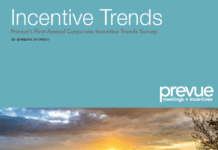 The Society for Incentive Travel Excellence (SITE) launched the latest research into the state of the incentive travel industry.
The Society for Incentive Travel Excellence (SITE) launched the latest research into the state of the incentive travel industry.
Partnering with Incentive Research Foundation (IRF) and Financial & Insurance Conference Professionals (FICP)—two organizations with a huge focus on incentive travel—along with Oxford Economics, SITE recently released the second annual Incentive Travel Industry Index.
“Incentive travel’s unique contribution to building corporate culture is probably the single biggest story emerging from this year’s Incentive Travel Industry Index (ITII),” said John Iannini, vice president, business travel and meetings & events, Melia Hotels International, and SITE Foundation president. Here are some key findings:
The benefits of soft power
While increased sales/profits and productivity were cited as the top two benefits of incentive travel programs, soft-power objectives such as improved engagement, enhanced customer satisfaction, improved retention, better relationship building and increased mindshare ranked close behind them.
“The corporate world has never been as focused on culture, mission, vision, and values,” said Iannini. “This is backed up by articles in major business publications including the Harvard Business Review and in the Business Roundtable statements on August 19, that effectively redefined the nature of the corporation taking it way beyond profit and highlighting all the soft power elements as well,” he said.
Experience is king
“Memories created on an incentive travel program allow groups to share a common thread or theme that builds and reinforces corporate culture in ways that they can share via their social media outlet,” said Iannini.
Respondents ranked offering one-of-a-kind, exclusive experiences number one among actions companies take when competing for incentive travel contracts.
Feedback is the true measurement
Additionally, the survey reported that participant satisfaction or feedback ranked above ROI and ROO in terms of effectiveness in demonstrating the value of a program to senior management.
Budgets grow
In 2019, 42% of incentive travel budgets were up; 27% remained the same, and only 20% dropped as compared with last year. The trend is projected to continue with 53% of 2022 budgets expect to increase, 30% to remain unchanged and only 17% to drop.
Wellness tops activity trends
Wellness is the biggest trend in program activities, jumping from a 41% inclusion in 2018 and 2019 programs to a projected 64% in 2020 and 2021. Teambuilding and networking events, while still important, are projected to decline from 67% currently to 59% in the next two years. Learning and development unique to the destination is projected to remain at 61%; inclusion of spouses is expected to decline slightly from 60% to 59% and mandated activities are projected to decline from 51% to 34%. In addition, golf and other competitive sports are projected to drop from the current 37% to 26%.
DON’T MISS THESE RELATED ARTICLES
Many Planners Use Trial and Error to Design Their Incentive Programs
A Chat With Creative Group’s Melissa Van Dyke
3 Behavioral Economic and Neuroscience Findings to Improve Incentive Travel










